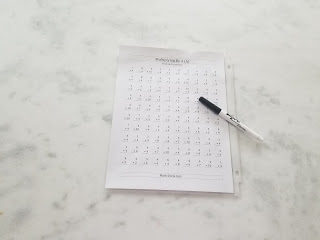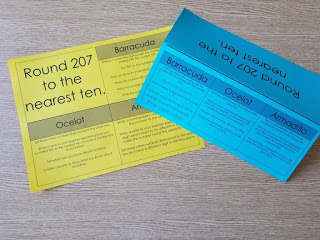The thought of differentiating for Guided Math might leave you having heart palpitations. How can you differentiate without making yourself have HOURS more to plan each week?
Here are some simple ways you can differentiate for Guided Math.
Take Advantage of Technology
If you are fortunate enough to have access to technology in your classroom, you should definitely make it a part of your Guided Math time. There are many websites and apps that will automatically individualize the experience for each student, making for automatic differentiation! Xtramath is a good website for fact fluency practice. (In the Guide Book below you can find other teacher recommended websites!)
Fluency Sheets
I give all of my students a fluency sheet in a sheet protector and they keep it in their desks. Any time they finish an activity early they can work on their fluency sheet. They just use a dry erase marker to practice their facts and flip the sheet over to see the answer key which I have put on the back. This is an easy thing to add to your Flexible Guided Math routine as one of your Must Do activities!
You can differentiate these sheets based on your students’ abilities. Some students may work on addition, others subtraction, others multiplication, etc… You can get free fluency sheets (with answer keys) from math-drills.com
Level UP or Level DOWN
Too Hard?
- If the material is entirely too hard and your students are not READY to grasp it, look at the standards from the previous grade level. Address those during your lesson to try to fill gaps.
- Use smaller numbers to help students understand concepts. Once they are comfortable, use larger numbers.
- Continue to work with them to build fact fluency.
Too Easy?
- If your students QUICKLY grasped the material, you can push them by looking at the standards from the next grade level. I’m not saying you should teach the next grade level’s content—but what you can do is look and see what they will be expected to be able to do. You can help bridge the gap between the grade level expectations by preparing them for the more advanced skills.
- Use larger numbers.
- Challenge students to use other strategies. Make sure they do not simply have facts memorized…but actually understand what they are doing. (For example…if they are solving a multiplication word problem, make sure they are not simply pulling to digits out of the problem and multiplying them. Make sure they understand the concept of multiplication as well.)
BOA Activities
BOA stands for Below, On, and Above grade level. Of course, you don’t want students to know what they stand for so you can give them fun names.
You can take any problem, and expand it by giving your students another task to do. Students will not know what B, O, and A, stand for—but you will.
This is a super easy way to differentiate because you can tell each student what task to do. You don’t have to have below, on, or above grade level groups. BOA activities can work really well with a flexible Guided Math set up. (Flexible Guided Math..what’s that?? Learn more here!)
Learn how I teach Guided Math!








